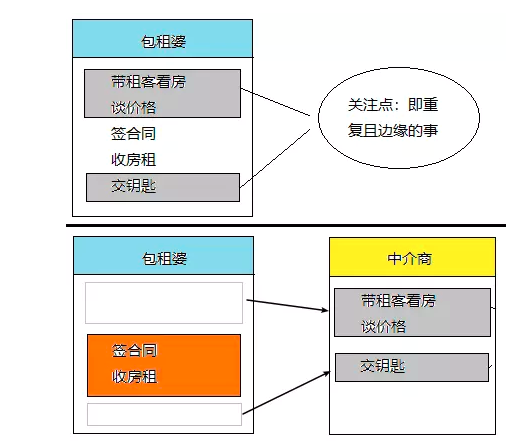Spring AOP 简介
Spring AOP 简介
如果说 IoC 是 Spring 的核心,那么面向切面编程就是 Spring 最为重要的功能之一了,在数据库事务中切面编程被广泛使用。
AOP 即 Aspect Oriented Program 面向切面编程
首先,在面向切面编程的思想里面,把功能分为核心业务功能,和周边功能。
- 所谓的核心业务,比如登陆,增加数据,删除数据都叫核心业务
- 所谓的周边功能,比如性能统计,日志,事务管理等等
周边功能在 Spring 的面向切面编程AOP思想里,即被定义为切面
在面向切面编程AOP的思想里面,核心业务功能和切面功能分别独立进行开发,然后把切面功能和核心业务功能 "编织" 在一起,这就叫AOP
AOP 的目的
AOP能够将那些与业务无关,却为业务模块所共同调用的逻辑或责任(例如事务处理、日志管理、权限控制等)封装起来,便于减少系统的重复代码,降低模块间的耦合度,并有利于未来的可拓展性和可维护性。
AOP 当中的概念:
- 切入点(Pointcut)
在哪些类,哪些方法上切入(where) - 通知(Advice)
在方法执行的什么实际(when:方法前/方法后/方法前后)做什么(what:增强的功能) - 切面(Aspect)
切面 = 切入点 + 通知,通俗点就是:在什么时机,什么地方,做什么增强! - 织入(Weaving)
把切面加入到对象,并创建出代理对象的过程。(由 Spring 来完成)
为了更好的说明 AOP 的概念,我们来举一个实际中的例子来说明:

在上面的例子中,包租婆的核心业务就是签合同,收房租,那么这就够了,灰色框起来的部分都是重复且边缘的事,交给中介商就好了,这就是 AOP 的一个思想:让关注点代码与业务代码分离!
我们来实际的用代码感受一下
package pojo;
import org.springframework.stereotype.Component;
@Component("landlord")
public class Landlord {
public void service() {
// 仅仅只是实现了核心的业务功能
System.out.println("签合同");
System.out.println("收房租");
}
}
package aspect; import org.aspectj.lang.annotation.After;
import org.aspectj.lang.annotation.Aspect;
import org.aspectj.lang.annotation.Before;
import org.springframework.stereotype.Component; @Component
@Aspect
class Broker { @Before("execution(* pojo.Landlord.service())")
public void before(){
System.out.println("带租客看房");
System.out.println("谈价格");
} @After("execution(* pojo.Landlord.service())")
public void after(){
System.out.println("交钥匙");
}
}
在 applicationContext.xml 中配置自动注入,并告诉 Spring IoC 容器去哪里扫描这两个 Bean:
<?xml version="1.0" encoding="UTF-8"?>
<beans xmlns="http://www.springframework.org/schema/beans"
xmlns:xsi="http://www.w3.org/2001/XMLSchema-instance"
xmlns:context="http://www.springframework.org/schema/context"
xmlns:aop="http://www.springframework.org/schema/aop"
xsi:schemaLocation="http://www.springframework.org/schema/beans
http://www.springframework.org/schema/beans/spring-beans.xsd http://www.springframework.org/schema/context http://www.springframework.org/schema/context/spring-context.xsd http://www.springframework.org/schema/aop http://www.springframework.org/schema/aop/spring-aop.xsd"> <context:component-scan base-package="aspect" />
<context:component-scan base-package="pojo" /> <aop:aspectj-autoproxy/>
</beans>
测试代码
package test; import org.springframework.context.ApplicationContext;
import org.springframework.context.support.ClassPathXmlApplicationContext;
import pojo.Landlord; public class TestSpring { public static void main(String[] args) { ApplicationContext context =
new ClassPathXmlApplicationContext("applicationContext.xml");
Landlord landlord = (Landlord) context.getBean("landlord", Landlord.class);
landlord.service(); }
}
执行结果

使用注解来开发 Spring AOP
使用注解的方式已经逐渐成为了主流,所以我们利用上面的例子来说明如何用注解来开发 Spring AOP
第一步:选择连接点
Spring 是方法级别的 AOP 框架,我们主要也是以某个类额某个方法作为连接点,另一种说法就是:选择哪一个类的哪一方法用以增强功能。

我们在这里就选择上述 Landlord 类中的 service() 方法作为连接点。
第二步:创建切面
选择好了连接点就可以创建切面了,我们可以把切面理解为一个拦截器,当程序运行到连接点的时候,被拦截下来,在开头加入了初始化的方法,在结尾也加入了销毁的方法而已,在 Spring 中只要使用 @Aspect 注解一个类,那么 Spring IoC 容器就会认为这是一个切面了:
package aspect; import org.aspectj.lang.annotation.After;
import org.aspectj.lang.annotation.Aspect;
import org.aspectj.lang.annotation.Before;
import org.springframework.stereotype.Component; @Component
@Aspect
class Broker { @Before("execution(* pojo.Landlord.service())")
public void before(){
System.out.println("带租客看房");
System.out.println("谈价格");
} @After("execution(* pojo.Landlord.service())")
public void after(){
System.out.println("交钥匙");
}
}
- 注意: 被定义为切面的类仍然是一个 Bean ,需要
@Component注解标注

有了上表,我们就知道 before() 方法是连接点方法调用前调用的方法,而 after() 方法则相反,这些注解中间使用了定义切点的正则式,也就是告诉 Spring AOP 需要拦截什么对象的什么方法,下面讲到。
第三步:定义切点
在上面的注解中定义了 execution 的正则表达式,Spring 通过这个正则表达式判断具体要拦截的是哪一个类的哪一个方法:
execution(* pojo.Landlord.service())
依次对这个表达式作出分析:
- execution:代表执行方法的时候会触发
*:代表任意返回类型的方法- pojo.Landlord:代表类的全限定名
- service():被拦截的方法名称
通过上面的表达式,Spring 就会知道应该拦截 pojo.Lnadlord 类下的 service() 方法。上面的演示类还好,如果多出都需要写这样的表达式难免会有些复杂,我们可以通过使用 @Pointcut 注解来定义一个切点来避免这样的麻烦:
package aspect; import org.aspectj.lang.annotation.After;
import org.aspectj.lang.annotation.Aspect;
import org.aspectj.lang.annotation.Before;
import org.aspectj.lang.annotation.Pointcut;
import org.springframework.stereotype.Component; @Component
@Aspect
class Broker { @Pointcut("execution(* pojo.Landlord.service())")
public void lService() {
} @Before("lService()")
public void before() {
System.out.println("带租客看房");
System.out.println("谈价格");
} @After("lService()")
public void after() {
System.out.println("交钥匙");
}
}
测试结果

Spring AOP 简介的更多相关文章
- Spring AOP 简介(三)
Spring AOP 简介 如果说 IoC 是 Spring 的核心,那么面向切面编程就是 Spring 最为重要的功能之一了,在数据库事务中切面编程被广泛使用. AOP 即 Aspect Orien ...
- Spring AOP简介与底层实现机制——动态代理
AOP简介 AOP (Aspect Oriented Programing) 称为:面向切面编程,它是一种编程思想.AOP 是 OOP(面向对象编程 Object Oriented Programmi ...
- Spring AOP简介
AOP简述 AOP的概念早在上个世纪九十年代初就已经出现了,当时的研究人员通过对面向对象思想局限性的分析研究出了一种新的编程思想来帮助开发者减少代码重复提高开发效率,那就是AOP,Aspect-Ori ...
- Spring - AOP简介与图示
[1]AOP (Aspect-Oriented Programming, 面向切面编程),是一种新的方法论, 是对传统 OOP(Object-Oriented Programming, 面向对象编程) ...
- Spring学习(三)Spring AOP 简介
一.简介 定义 aop就是面向切面编程,在数据库事务中切面编程被广泛使用. 在面向切面编程的思想里面,把功能分为核心业务功能,和周边功能. 核心业务:比如登陆,增加数据,删除数据都叫核心业务 周边功能 ...
- Spring中的面向切面编程(AOP)简介
一.什么是AOP AOP(Aspect-Oriented Programming, 面向切面编程): 是一种新的方法论, 是对传统 OOP(Object-Oriented Programming, 面 ...
- Spring aop与HibernateTemplate——session管理(每事务一次 Session)
一.HibernateTemplate与Spring aop简介 参见http://bbs.csdn.net/topics/340207475中网友blueram的发言.(感谢blueram) 二.在 ...
- Spring AOP With AspectJ
一.AOP和拦截器 某些情况下,AOP和拦截器包括Filter能够实现同样的功能,一般都是请求即controller层的操作,这三个执行顺序为Filter>Interceptor>AOP, ...
- springmvc 运行原理 Spring ioc的实现原理 Mybatis工作流程 spring AOP实现原理
SpringMVC的工作原理图: SpringMVC流程 . 用户发送请求至前端控制器DispatcherServlet. . DispatcherServlet收到请求调用HandlerMappin ...
随机推荐
- react-webpack config webpack@3.4.1
1.最重要的一点 yarn add webpack@3.4.1 -g 2. 解决跨域请求 webpack.json 中添加 https://segmentfault.com/q/1010000008 ...
- Android adb 串口调试
adb (串口输入) echo 1 > /sys/class/remount/need_remount; mount -o rw,remount /system ...
- 菜鸟详细解析Cookie注入原理
一.SQL注入原理 我以aspx为例,现在我们来研究下Cookie注入是怎么产生的,在获取URL参数的时候,如果在代码中写成Request[“id”],这样的写法问题就出现了.我先普及下科普知识,在a ...
- ping vs telnet, what is the difference between them and when to use which?
Ping is an ICMP protocol. Basically any system with TCP/IP could respond to ICMP calls if they were ...
- Yocto和Android编译命令的简化和自动完成的实现
简化编译命令 无论是在Android编译系统中,还是在Yocto编译系统中,要编译一个目标,输入命令都有点费事. Yocto系统: source setup-environment $FOLDER b ...
- [SpringMVC]自定义注解实现控制器访问次数限制
我们需要根据IP去限制用户单位时间的访问次数,防止刷手机验证码,屏蔽注册机等,使用注解就非常灵活了 1 定义注解 @Retention(RetentionPolicy.RUNTIME) @Target ...
- xtrabackup工具备份与恢复
1.xtrabackup简介 Xtrabackup是一个对InnoDB做数据备份的工具,支持在线热备份(备份时不影响数据读写),是商业备份工具InnoDB Hotbackup的一个很好的替代品.它能对 ...
- df=df.reset_index(drop=True)
df=df.reset_index(drop=True) ============ df = pd.read_csv('./train_file/train.csv').dropna()df_test ...
- ==还款-代偿(csv循环自动代偿)
问题: 解决:传递参数错误,上一步就错了 问题:代偿返回这些信息 解决:传递参数错误,应该为${repayWay1},但是一直写的是${repayWay} 问题:如何从csv文件中逐条取项目编号,进行 ...
- deviceMotion.userAcceleration加速度方向
ios坐标系如图中所示,假设手机受到1个沿X正方向的力(假设该力产生了1m/s^2的加速度),那么deviceMotion.userAcceleration的值为多少呢? 答案是违反常识的:devic ...
